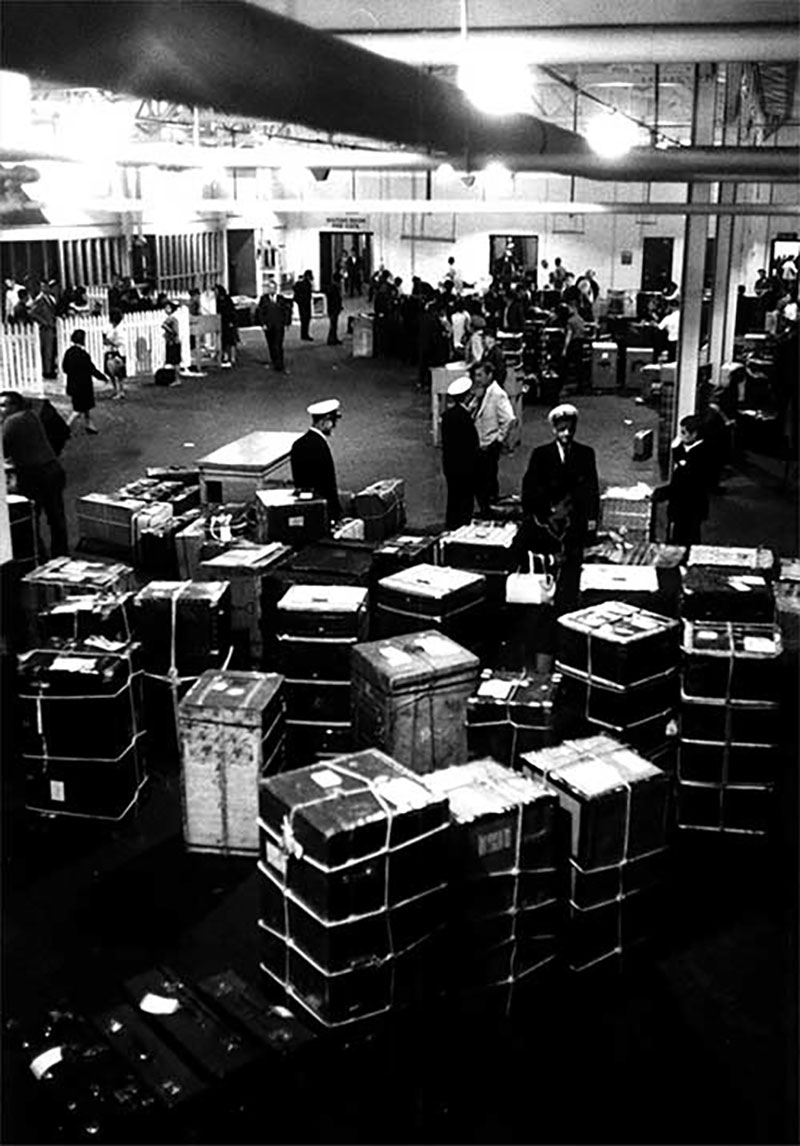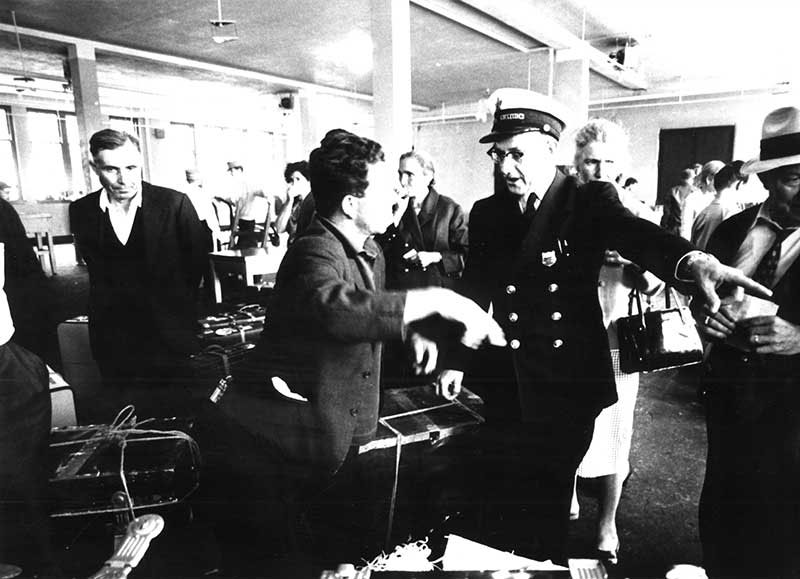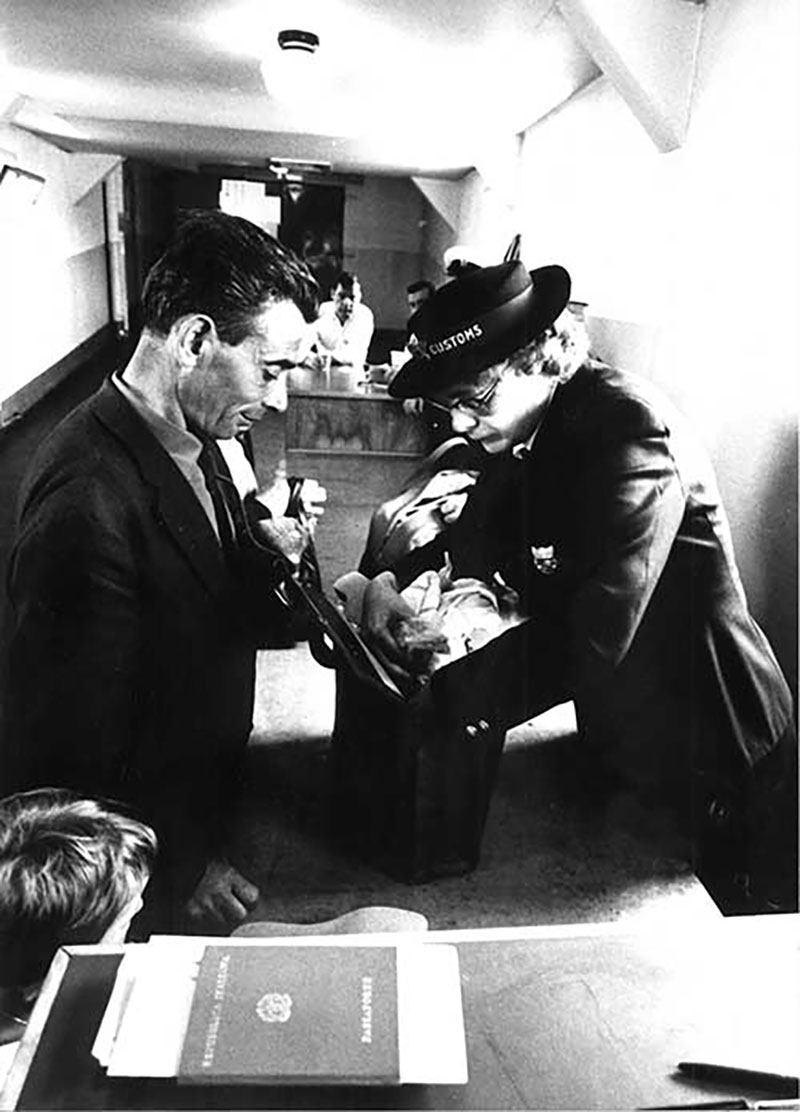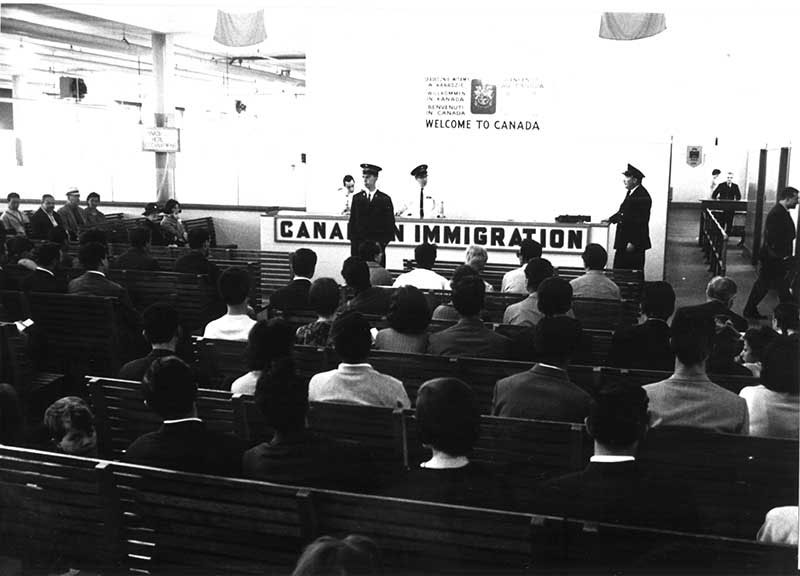by Jan Raska, PhD, Historian
(Updated November 5, 2020)
Introduction
“If one thing caused scenes at Pier 21, it was sausages.” This statement located on a panel in the Museum’s (pre-2015) core exhibition sheds light on an interesting yet underexplored aspect of Canadian immigration history: food confiscation.
Food can be a persistent feature of cultural traditions. It is uniquely tied to an individual’s sense of comfort, security, pride, social status and ethno-religious background. When immigrants and refugees arrive in Canada they often bring with them aspects of their culture that are important to them and their families. These aspects may include education, material possessions, language, religious identity, music, dance and ethnic background. In recent years, scholars of the migration experience have taken note that food and culinary traditions also played a major role in individual and family identities—often times becoming a person’s sole connection with their past.[1] When new arrivals brought food with them from the old homeland, they were in effect transplanting their cultural heritage—‘you are what you eat’ became ‘you eat what you are.’ In studying what immigrants ate and brought with them, we can “humanize” the past and give a voice to the experience of newcomers on their initial arrival to a new country.[2]
Immigrants and Customs Inspection at Pier 21
Newcomers often went to enormous efforts to conceal their food products from Canadian customs officers for fear of losing their beloved sausages, nuts, bread and other cherished food items. As immigrants came through Pier 21 and other ports of entry into Canada, many feared that what Canadians purchased as food remained of lesser quality than their old country’s foodstuffs. Conversely, customs officers were tasked with confiscating items such as meat to protect Canadian agriculture from disease. This middle ground often led to interesting exchanges between Canadian ‘gatekeepers’—those entrusted to safeguard Canadian society and its economy, including customs officers—and new arrivals from across the globe. The site of contest—Pier 21—was a series of buildings linked together by ramps to the local train station. The complex of buildings included various facilities such as a detention centre, hospital and Red Cross Seaport Nursery. The ocean immigration shed also accommodated officials representing the Immigration Branch, Canada Customs, Department of Agriculture, Department of Health and Welfare and representatives of various voluntary service organizations.
As the permanent exhibition panel on food indicated, sausages were an often contested item at Pier 21. This begs the question: what really happened when the immigration shed was still active? How did immigrants, interpreters and customs officials interact within the halls of Pier 21? What sorts of items were confiscated? Customs officials made sure that all arrivals’ hand luggage was checked. After immigrants had their documents processed, they were sent downstairs to locate their belongings which were stored in alphabetical order among boxes, crates and trunks.
Immigrant Experiences of Food Confiscation at Pier 21
The Kornelsens disembarked from SS Atlantic and immediately went to be processed by Canadian immigration officers. Having arrived on June 29, 1951 with their funds for train tickets yet to arrive and a Dominion Day (later renamed to Canada Day) weekend upon them, Harry, Heidi and Olie were forced to wait at Pier 21 until July 2. The family was offered bacon and hard-boiled eggs for breakfast, and mashed potatoes, peas, carrots and greens for dinner. The Kornelsens remark that they were able to taste an Italian sausage for the very first time thanks to an Italian immigrant who had brought it with him.[3]
Less than three years later, on June 22, 1954, Ilse Koerner, a German immigrant arrived in Halifax aboard SS Conte Biancamano from Genoa, Italy. She recalls that Canadian immigration authorities directed the newcomers’ luggage to be left along one wall in the immigration shed. Food that was confiscated from newcomers was “piled up in a heap in the middle of the hall. Rays of sunshine painted a colourful still of that mountain of sausages, loaves of bread, wheels of cheeses, fruits and other perishable items.”[4] Koerner brought with her two suitcases and two handbags on her journey towards a new life in Canada. In waiting to see an immigration official, Koerner sat in a chair in the immigration hall as children danced around the pile of confiscated food in the centre of the floor.[5]
Two years later, a mother and her four children sailed from Naples, Italy aboard the SS Roma Flotta Lauro in December 1956. Seeking to rejoin her husband who arrived five years earlier, Sofia Perri and her children arrived on Canadian shores on December 23, just in time for Christmas. Perri’s daughter, Anna, 10 years of age at the time of sailing recalls that Canadian Customs officers permitted her mother to enter the country with extra goods as she argued that she was travelling in a family of five members and therefore the food should be allowed. Customs officers failed to detect a capicollo (traditional Italian cold cut ham) in the family’s belongings which would have been seized. Reminiscing of her family’s arrival, Anna Perri noted that her mother witnessed entire containers of olive oil spilled on the floor when customs officers punctured a mattress they suspected of hiding food products. Although some experienced the agony of seeing their food—and more importantly precious examples of their ties to the old homeland—confiscated or destroyed, others were lucky. Children often smuggled food items such as salamis in their pockets only to share them later with family and new-found friends aboard the trains heading westward across the country from Halifax.[6]
On March 27, 1958, Anna Vozza and her family arrived in Halifax aboard the MS Saturnia. Vozza recalls that Pier 21 was a friendly place. The family was quickly processed through immigration and customs, and boarded a train for Toronto. The Vozzas received a loaf of sliced bread and Anna’s brother began to gesture that he was playing the accordion. Unfamiliar with the appearance, texture and taste of Canadian bread, it had apparently been mistaken for a musical instrument.[7]
Arriving with her two young children on November 21, 1961, Maria Pagano was reunited with her husband, Antonio, who arrived three years previously. After an eleven-day journey aboard MS Saturnia, Pagano remembers having her luggage checked by a customs officer at Pier 21. She had put a bag of beans in her luggage to bring to Canada only to see similar beans across the floor of the immigration hall: “Sure enough, when I found my trunk I saw that it was damaged and my beans had leaked out all over the place. I remember people saying ‘Where are all these beans coming from?’”[8] Once their luggage was examined by customs officials, the Paganos left for the Customs Office and were then sent to the train station. In passing a table in the warehouse, Pagano remembers that it contained a slew of confiscated items such as: prosciuttos, sausages, cheese, salamis and liquor bottles.[9] Many of these items were stored in luggage in the hopes that they would be shared with family and friends already in Canada. Such items often brought with them memories of the home left behind—of villages and towns left behind and of links with the past.
Responsibilities of Canadian Customs Officials at Pier 21
One of the prime responsibilities of Canadian customs officials was to prevent the spread of foot and mouth disease by examining immigrants’ baggage and personal items. When it came to new arrivals from Europe, officials at Pier 21 did not shy away from seeking out hidden foods including meat, flour, bread and beans. Arthur Vaughan, a customs officer at Pier 21 called this type of work “a most unglamorous occupation.”[10] When officers such as Vaughan located unpermitted foods, they were immediately turned over to the federal Department of Agriculture for immediate incineration at their offices. Customs officials learned to ask whether newcomers arriving at Pier 21 brought with them foodstuffs from home—sausages, prosciutto, salami, bread, olive oil, nuts and beans to name a few. Although many immigrants hoped that by answering ‘no’ to a customs official’s query whether they brought food to Canada, they could treat their families and friends with a sample of the taste of home, while others were not so lucky in having their contraband foodstuffs seized.[11]
Many immigrants were herded from one end of the immigration shed to the other on floors made of asphalt, past muddy-green and brown walls, overhead pipes, and wire cages that ran the length of the ceiling. Newcomers sat in one of eight rows of wooden seats and waited for their turn to meet an immigration official. Canadian immigration officer Bill Shaw recalls that “…while babies wailed and old people sat, quiet and resigned, and the kids littered the floor with orange peels.”[12]
Conclusion
Food not only tells us of what immigrants ate and brought with them on their journeys towards a new life in Canada, but it also shows us how individuals and families transplanted their cultural heritage to a new country. Food and its confiscation plays a vital role in the middle ground between an immigrant’s arrival in Canada—where they seek to bring food linking their old and new homes —and the desire of Canadian officials to protect the country from outside disease.

Credit: Canadian Museum of Immigration at Pier 21 Collection (R2013.1362.7)

Credit: Canadian Museum of Immigration at Pier 21 Collection (R2013.1362.42)

Credit: Canadian Museum of Immigration at Pier 21 Collection (DI2013.1362.6)

Credit: Canadian Museum of Immigration at Pier 21 Collection (R2013.1362.31)
- Thelma Barer-Stein, You Eat What You Are: People, Culture and Food Traditions (Toronto: McClelland & Stewart, 1999), 14-15.
- Megan Elias, “Summoning the Food Ghosts: Food History as Public History,” Public Historian 34.2 (May 2012): 13.
- Immigration Story of Harry and Heidi Kornelson, Canadian Museum of Immigration at Pier 21 (hereafter CMI) Collection (S2012.479.1).
- Immigration Story of Ilse Koerner, CMI Collection (S2012.169.1).
- Immigration Story of Ilse Koerner.
- Immigration Story of Sofia Perri, CMI Collection (S2012.1718.1).
- Immigration Story of Anna Vozza, CMI Collection (S2012.532.1).
- Immigration Story of Maria Rosaria Pagano, CMI Collection (S2012.246.1).
- Immigration Story of Maria Rosaria Pagano.
- Immigration Story of Maria Rosaria Pagano; Pier 21 Staff Story of Arthur J. Vaughan, CMI Collection (S2012.808.1).
- Immigration Story of Maria Rosaria Pagano; Pier 21 Staff Story of Arthur J. Vaughan.
- “Bill Shaw’s gate to the Promised Land,” Maclean’s (January 1970), 30.
